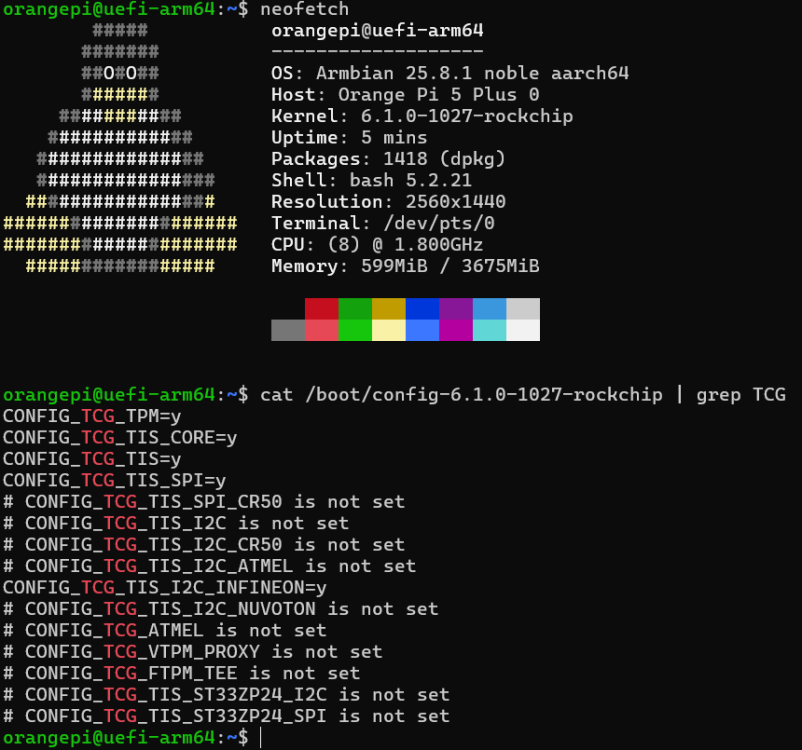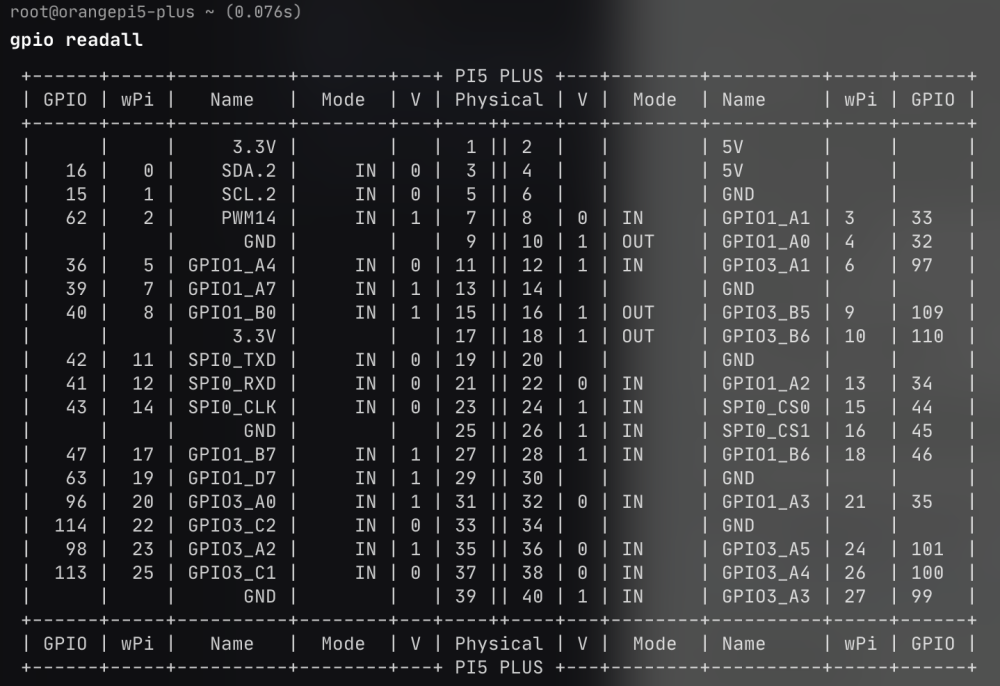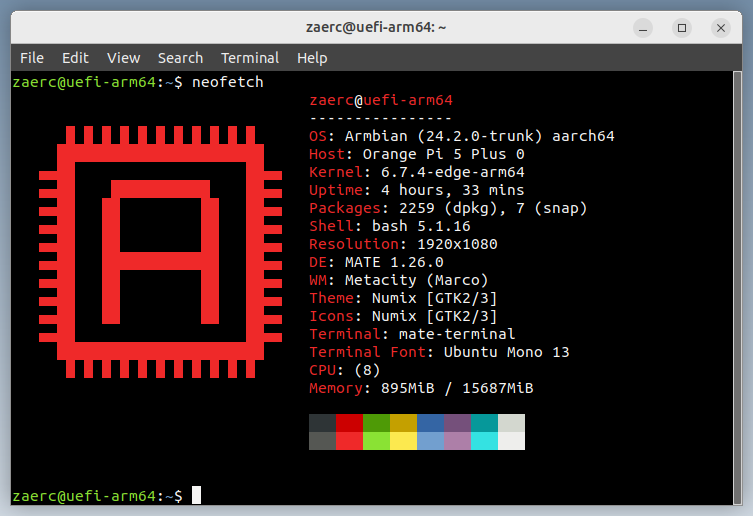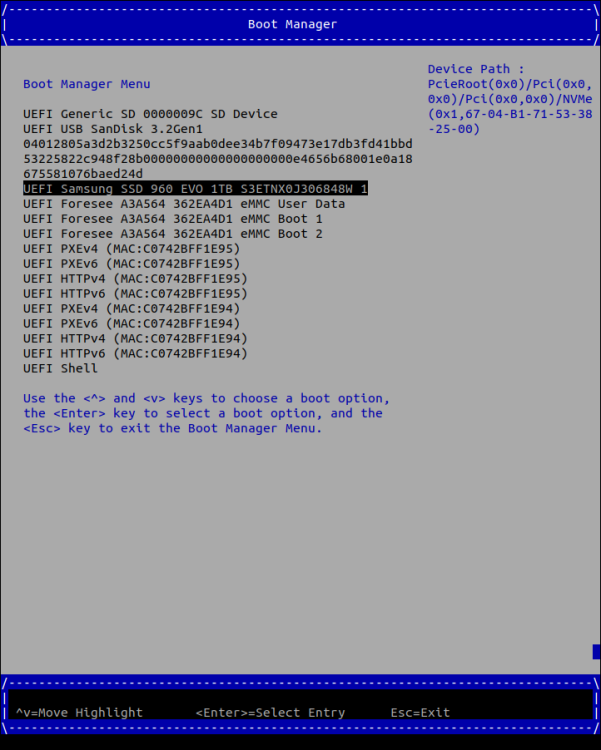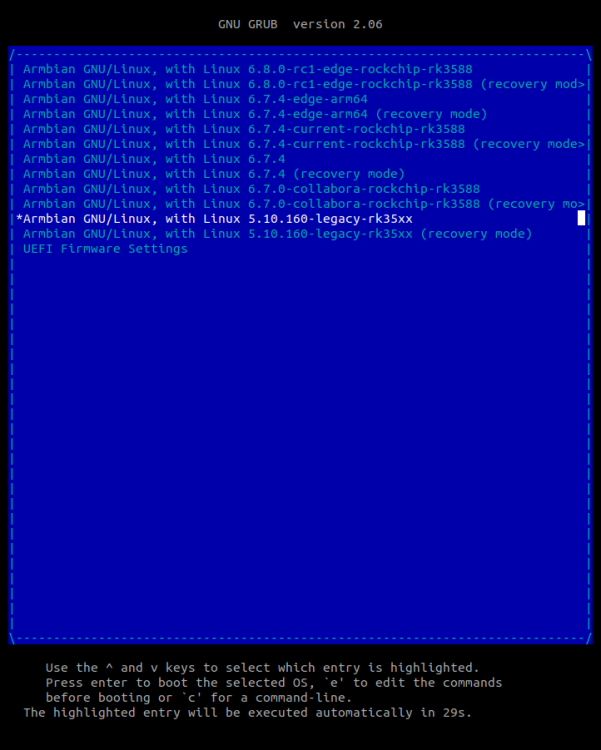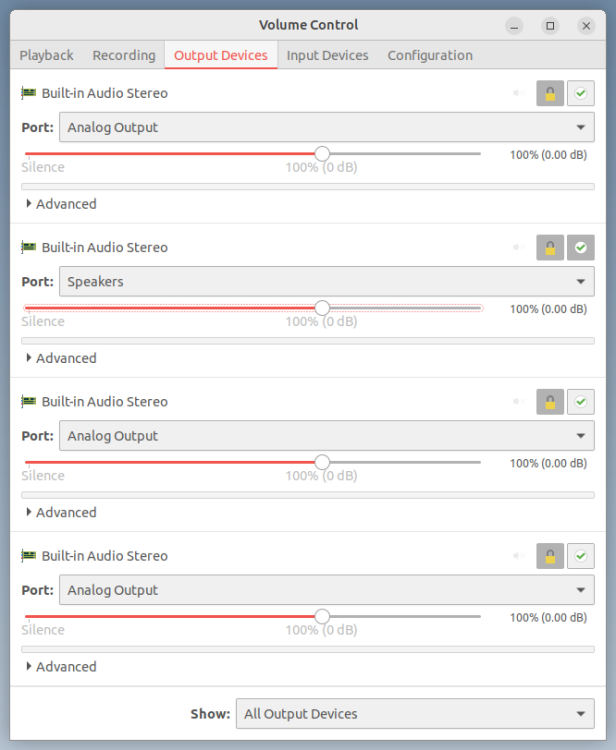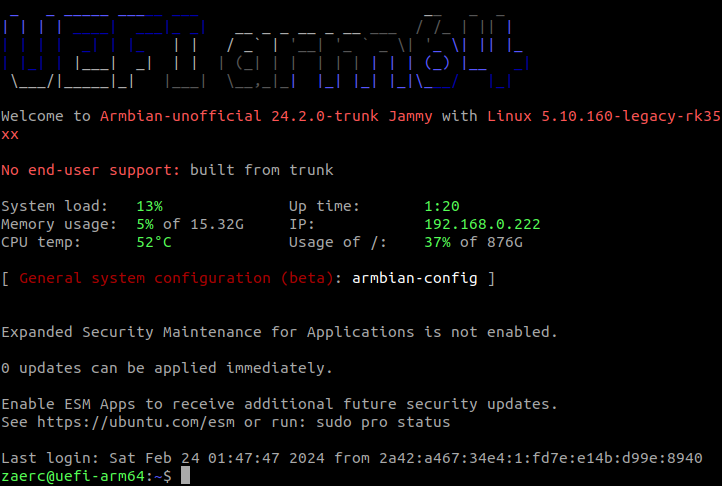Search the Community
Showing results for tags 'orangepi5plus'.
-
I understand that panthor is not supported for wayland but in that case I would expect libmali to fill in... but I ended up with lvmpipe. The overlay along with another recent post led me to believe that panthor was the expected default and libmali was an artifact, but I'm now questioning that after finding a thread identifying use cases where libmali can be preferred and a comment suggesting panthor wouldn't be available until 6.13. As a result, I am now questioning if there is a reason that software acceleration is the default and the user is expected to determine which path they want to go? I know support for the hardware has been slow going so I understand that it's not well supported yet, but hoping to get a better handle on expectations. Is there an expected default for a Rockchip RK3588 SoC with the Mali‑G610 GPU? Does it vary between 6.1/6.12 and the desktop/server builds?
-
I've already benchmarked a computer-interactivbe task (like image processing) on the Orangepi 5 plus's processor——and it wrapped up in just 40 minutes, which is impressively fast. Therefore, I' like to try the NPU. Anyone know how to tap into its NPU for AI workloads?
-
Why so few Debian (Trixie) images with this batch of newly released images? Not one full desktop image for Debian?
-
Hi All, I'm struggling with my Orange PI 5 Plus and various Armbian Flavors for 3 days. My Preferred DE, Armbian_25.8.1_Orangepi5-plus_noble_vendor_6.1.115_kde-neon_desktop, after all setup on second boot... failed msg: wait until boot finishes... XFCE, Sound does not work over HDMI. Finally, Armbian_25.8.1_Orangepi5-plus_trixie_vendor_6.1.115_cinnamon_desktop, is doing well. Except for, I'm missing start button. If I want Firefox, I have to open it via cmd If I want to capture screen... I dont know even the name to call via cmd... See my Phone shot https://drive.google.com/file/d/1d6K4i_yshHCrKvXR-13VFkpWzPKx8GaA/view?usp=sharing Could somebody tell me what is wrong? Thanks,
-
Hi Guys, I just did a new custom Armbian build ./compile.sh BOARD=orangepi5-plus BRANCH=vendor RELEASE=noble KERNEL_ONLY=yes KERNEL_CONFIGURE=no. The image is Armbian-unofficial_25.11.0-trunk_Orangepi5-plus_noble_vendor_6.1.115_cinnamon_desktop and when I installed it on orangepi I see it is not supporting Panfrost/Mail: glxinfo | grep -E "OpenGL renderer|OpenGL version" OpenGL renderer string: llvmpipe (LLVM 20.1.2, 128 bits) OpenGL version string: 4.5 (Compatibility Profile) Mesa 25.0.7-0ubuntu0.24.04.2 but for older image Old_Armbian-unofficial_25.08.0-trunk_Orangepi5-plus_noble_vendor_6.1.115_cinnamon_desktop All was well glxinfo | grep -E "OpenGL renderer|OpenGL version" OpenGL renderer string: Mali-G610 (Panfrost) OpenGL version string: 3.1 Mesa 25.0.7-0ubuntu0.24.04.2 I did need to enable "ARM Mail Display Processor" under Device Drivers -> Graphics support -> ARM devices before I perform custom build. And I did this for both OS version 25.11.0 and 25.08.0. But newer version is not able to use it. Thanks Manish
-
I have tried to download at least 3 times this image: Armbian_25.8.1_Orangepi5-plus_noble_vendor_6.1.115_gnome_desktop.img.xz All sha256sum verified Ok. And wrote 5 times on 3 different SDCards, and this img does not boot on my OPI-5-Plus. No image on monitor, partition armbi_root not expanded, no green lights... Just unusable (for me). Other img's that boot are OK: Deb-xfce, noble-cinnamon, noble-neon... Someone got success with this img??? I'm looking for a distro that works well on OPI5-Plus, well configured, and that works with HDMI audio. The best for now is Noble-Cinnamon but failed to setup Menu button, and I cant find support until now to solve this issue. Thanks, Cury
-
I've heard people say that the Orange Pi is a "budget alternative" to the Raspberry Pi. On one hand, the Raspberry Pi has an excellent community, with a large user base that could really help you in your learning journey. On the other hand, the Orange Pi offers great value for money, and it's really tempting because the Raspberry Pi can be a bit pricey. What's your suggestion?
-
I’m currently using the Armbian build system to generate images for the Orange Pi 5 Plus. To use the PREEMPT_RT kernel, I set the BRANCH to current, and with the PREEMPT_RT configuration on the 6.12 kernel I was able to successfully build the image and boot it. However, in this kernel version there are no dtbo files for peripherals like can0, i2c, etc., so I’m unable to use those interfaces. If I set the BRANCH to vendor, I can use the 6.1 kernel, but in order to use a PREEMPT_RT kernel I need to apply the RT patch. The RT patch currently provided is not compatible with the current BRANCH, so kernel build and image creation fail. My question is: while using the 6.12 current kernel, is there any way to copy and use the dtb and dtbo files from the 6.1 vendor kernel?
-
Hello, I've been using https://joshua-riek.github.io/ubuntu-rockchip-download/boards/orangepi-5-plus.html with a custom kernel that I built to activate my TPM2.0 device and it works. Now I'm asked to use an UEFI compatible image with my Orange Pi 5 Plus. So what I did is more or less the same thing that in here But instead of the legacy kernel I used the 6.1.115-rockchip-vendor-rk35xx kernel and my device booted, I got an HDMI output, etc. And then I updated it to my custom kernel (6.1.0-1027-rockchip) that has the necessary configurations to allow TPM over SPI. Now I'm trying to activate my TPM2.0 as I did before. To do that I added my compiled *.dtbo (rk3588-spi0-tpm-cs1.dtbo) to /boot/dtb/rockchip/overlay and activated it with armbian-config. After reboot this is my /boot/armbianEnv.txt orangepi@uefi-arm64:~$ cat /boot/armbianEnv.txt verbosity=1 bootlogo=true console=both extraargs=cma=256M overlay_prefix=rk3588 fdtfile=rockchip/rk3588-orangepi-5-plus.dtb rootdev=UUID=3e555b58-fdf4-4e2f-a3af-a8ecfd8034b6 rootfstype=ext4 overlays=spi0-tpm-cs1 param_spidev_spi_bus=0 However I still can't see my tpm under /dev/. I don't know what I'm missing, I'm quite new to this sorry Thank you for your time
-
Hi , I am trying to configure orangepi to turn on and turn off tv. I installed and used cec-ctl to register the boad as playbac device. And then was able to put the TV on standby mode via sudo cec-ctl --device /dev/cec0 --standby --to 0 but not able to find how to turn ON the TV. Can someone please help. Thanks Manish
-
Hello everyone! I was struggling to make wiring work on OrangePi 5 Plus armbian. Tried everything and came up with a solution that worked for me. I was constantly getting these errors: wiringPiSetup: mmap (PWM) failed: Operation not permitted wiringPiSetup: mmap (GPIO) failed: Operation not permitted I'm on 23.8.2. 1. Install armbian and update apt sudo apt update 2. As stated in OrangePi5Plus wiki page I got .deb installer for wiringPi on OrangePi Now here's the link to this file: https://github.com/orangepi-xunlong/orangepi-build/blob/next/external/cache/debs/arm64/wiringpi_2.51.deb 3. The most important step was described here: https://github.com/Joshua-Riek/ubuntu-rockchip/issues/273 echo "BOARD=orangepi5plus" | sudo tee /etc/orangepi-release Somehow this solves the issue. No idea how these things work tbh... 4. Check if pins are detected via gpio readall or add sudo sudo gpio readall You should get a table with all the pins and numbers like this: 5. Install wiringop-python just as stated in the manual: http://www.orangepi.org/orangepiwiki/index.php/Orange_Pi_5_Plus#How_to_install_wiringOP-Python # get the dependencies sudo apt-get update sudo apt-get -y install git swig python3-dev python3-setuptools # clone wiringOP-python repo, the branch should be "next" and NOT "main" or "master" git clone --recursive https://github.com/orangepi-xunlong/wiringOP-Python -b next cd wiringOP-Python git submodule update --init --remote python3 generate-bindings.py > bindings.i sudo python3 setup.py install The wiringOP-Python should be working now.
-
due to network limitations, how to compile Ubuntu 22.04 Gnome OS image in offline mode, build.sh need to download many debs,can I download them in advance,then install them locally. I have already downloaded kernel and uboot.
-
In settings -> keyboard -> view and customize shortcuts -> launchers -> search I am trying to set this to Windows Key + S, it doesn't register the windows key at all as being pressed, so what keyboard do I choose to be able to use the full k400r keyboard inclusive of the windows key. Many thanks Newbie (please be nice, I'm new to Armbian and SBC's)
-
I recently bought an orange pi plus and am using the armbian 6.12 server (https://dl.armbian.com/orangepi5-plus/Noble_current_server) I'm wanting to setup hardware acceleration for jellyfin but having trouble with the right steps. I'm using jellyfin inside docker on the orange pi inside armbian. I've found various tutorials but it seems like some of them reference things that no longer exist (like panfork seems to no longer be needed for latest mesa if I'm understanding correctly?), so wanting to see what I need to do to set this up. So it seems like I need to disable panthor and use mali instead, but I can't find in the armbian config menu the option to do that, and not sure if I know how to get the right mali. Any help would be greatly appreciated. armbianmonitor is at https://paste.armbian.com/nurazajipu I've seen these tutorials/posts for reference: * https://akashrajpurohit.com/blog/setup-jellyfin-with-hardware-acceleration-on-orange-pi-5-rockchip-rk3558/ * https://github.com/andyshrk/mesa/blob/panthor-v4/Panfrost-build-howto.md * https://forum.jellyfin.org/t-solved-hw-transcoding-rk3588-arch-not-working?pid=54084 * `https://forum.armbian.com/topic/49115-how-to-install-opencl-on-orangepi-5-plus/` * https://forum.jellyfin.org/t-rockchip-transcode-missing-dev-mali0
-
Hello, I just got a wifi 7 adapter (QCNCM865) and I was thinking the ath12k driver was available starting from kernel 6.13, I'm running the edge kernel 6.16.4 and the ath12k driver is failing to load and I can't find any wireless drivers in /usr/lib/modules/6.16.4-edge-rockchip64/kernel/net/wireless. Do I need to rebuild the kernel with the ath12k driver? or is there a kernel version available with that driver? Thanks for your help!
-
So I was messing around with my new OrangePi-5+ and installed the EDK2 UEFI firmware for Rockchip RK3588 platforms onto the SPI flash (/dev/mtdblock0). After which I tried all sorts of images and kernels with varying success, only the 5.10.160-legacy-rk3588 kernel would really have a working display. Until I tried a generic UEFI arm64 image (Jammy-CLI on a USB stick) which gave a working display, albeit at 1080p max. (my monitor is 4K) with no acceleration (after the extra steps), and installed the Mate desktop (just my preference). The big caveat is that it does not recognize the SD-card, EMMC or SPI-flash, just regular drives (e.g. sda/nvme0n1 etc) and I'm sure a lot of other hardware isn't properly recognized either. But all of that was fixed by simply installing the old legacy kernel with apt, making a symbolic link to the correct dtb in /boot and updating grub, and a reboot later everything worked fine, the desktop popped up in 4K with acceleration and all. In the end I installed the whole thing to an NVME with armbian-config, which didn't create the separate EFI partition, so I had to corrected it manually, but that is another story. What surprises me is that the UEFI-arm64 kernel does not seem to need a Device-Tree-Blob, in fact it doesn't even boot with its own rk3588-orangepi-5-plus.dtb. Anyway if anyone want's to try this I'd suggest using Balena etcher to write the ED2K firmware onto an SD-card, and a generic UEFI armbian to an USB stick so you won't have to mess up anything permanently. Plug the stick in a USB2 port as it chokes during boot on the USB3 (blue) ports. And you will need a lot of patience as booting from a USB2 stick will be rather slow to say the least. Install legacy kernel: sudo apt update sudo apt install linux-image-legacy-rk35xx Create the symbolic link: (If you try this on another board or with another kernel version, you will need to adjust the link for the appropriate DTB instead) sudo ln -s /usr/lib/linux-image-5.10.160-legacy-rk35xx/rockchip/rk3588-orangepi-5-plus.dtb /boot/dtb-5.10.160-legacy-rk35xx Bonus tip, set the legacy kernel as a GRUB's default: (optional, adjust for different kernels) sudo echo 'GRUB_DEFAULT="Armbian GNU/Linux, with Linux 5.10.160-legacy-rk35xx"' > /etc/default/grub.d/99-legacy.cfg GRUB should now automatically pick up on the DTB after updating: sudo update-grub So far the only downside I have found is that the audio outputs are all labeled "Built-in Audio Stereo", which was easy to solve by adding some udev-rules as the Armbian build system does when building a regular OrangePi-5+ image.
-
Hi Guys, I just did a new custom Armbian build ./compile.sh BOARD=orangepi5-plus BRANCH=vendor RELEASE=noble KERNEL_ONLY=yes KERNEL_CONFIGURE=no. The image is Armbian-unofficial_25.11.0-trunk_Orangepi5-plus_noble_vendor_6.1.115_cinnamon_desktop and when I installed it on orangepi I see it is not supporting Panfrost/Mail: glxinfo | grep -E "OpenGL renderer|OpenGL version" OpenGL renderer string: llvmpipe (LLVM 20.1.2, 128 bits) OpenGL version string: 4.5 (Compatibility Profile) Mesa 25.0.7-0ubuntu0.24.04.2 but for older image Old_Armbian-unofficial_25.08.0-trunk_Orangepi5-plus_noble_vendor_6.1.115_cinnamon_desktop All was well glxinfo | grep -E "OpenGL renderer|OpenGL version" OpenGL renderer string: Mali-G610 (Panfrost) OpenGL version string: 3.1 Mesa 25.0.7-0ubuntu0.24.04.2 I did need to enable "ARM Mail Display Processor" under Device Drivers -> Graphics support -> ARM devices before I perform custom build. And I did this for both OS version 25.11.0 and 25.08.0. But newer version is not able to use it. Thanks Manish
-
I'm adding this here as I want to contribute to the community, but I'm still not sure how. I've been playing with Armbian Build lately and found it's great for quick build images for testing purposes before it's officially made available. So I started build my own images with i3, mate, kde, and I noticed that, in my personal taste, the one that was better suited for my needs was Sway, but there's no desktop image with it. So I built a Server version and start installing it. I know it may not be of interest of everybody, so I was planning to do it for myself, so I can continue building with the interface, but having Sway "automatically" installed. If/when I'm able to do this, I could put this in CSC mode in the repo, or I shouldn't do that as it's going to bloat the system more as there's no interest in having yet another WM/DE available? I'm thinking of this as an alternative to i3,as I noticed that, in my board, Wayland is performing much better than XOrg/X11.
-
Hey @amazingfate, I have an issue with the build-in IR receiver on my OPI5+: ##O#O## OS: Armbian 25.8.1 noble aarch64 ####### Host: Orange Pi 5 Plus ########### Kernel: 6.1.115-vendor-rk35xx ############# Uptime: 2 mins ############### Packages: 1934 (dpkg), 5 (snap) ################ Shell: bash 5.2.21 ################# Resolution: 3840x2160 ##################### DE: GNOME 46.0 ##################### WM: Mutter ################# WM Theme: Adwaita Theme: Adwaita [GTK2/3] Icons: Adwaita [GTK2/3] Terminal: x-terminal-emul CPU: (8) @ 1.800GHz Memory: 2585MiB / 15957MiB After a reboot it works just fine, but once I suspend/resume it stops working. Logs look clear of errors. I have tried to troubleshoot with ChatGPT but goin' in circles and gave up. Lastly ended up with some speculations from it like: static int rockchip_pwm_remotectl_resume(struct device *dev) { struct remotectl_dev *rc_dev = dev_get_drvdata(dev); // Re-init or restart the device if (rc_dev && rc_dev->restart) rc_dev->restart(rc_dev); return 0; } static const struct dev_pm_ops rockchip_pwm_remotectl_pm_ops = { .resume = rockchip_pwm_remotectl_resume, }; static struct platform_driver rockchip_pwm_remotectl_driver = { .probe = rockchip_pwm_remotectl_probe, .driver = { .name = "rockchip_pwm_remotectl", .pm = &rockchip_pwm_remotectl_pm_ops, }, }; Do you think this is the problem, or if not can I share some details so you can try to find it?
-
Hi there I'm using Ubuntu 24.04 (Noble) KDE Neon image from may 26, 2025. After download this image and installing it, Wayland was working fine, not problems at all. Then, after a system upgrade, if i choose Wayland from session manager, the system freezes and i can't boot with Wayland, only X11... Before the update, the system was smooth, now it's really laggy....Like i said, i'm using Desktop image with Armbian Linux v6.12 KDE Neon (Ubuntu 24.04) There's something wrong with the update Anyone knows why is this happening, and any turnaround to use Wayland again?
-
Hardware: OrangePI-5-Plus (rk3588), with "32 GB" of RAM Operating System: Debian Trixie (pure, except EFI boot and Armbian edge kernel) Root File System: Ext4 (encrypted) Desktop: KDE Plasma 6.3.6 (wayland, GDM3), KDE Frameworks version: 6.13.0, QT version: 6.8.2 EFI Source: https://github.com/edk2-porting/edk2-rk3588 The boot messages, after a few starts (spaced apart) of the low-memory-monitor.service, say there's a failure to start it. After booting is complete, here's a screenshot of the output of: systemctl status low-memory-monitor.service This error didn't show up until I installed a number of packages. I tracked down the offending package from the Trixie repository: Package: xfsprogs Version: 6.13.0-2+b1 Size: 4774 kB Description: A set of commands to use the XFS filesystem, including mkfs.xfs Once this package was removed, the error vanished, and a repeat of the above Status command reported low-memory-monitor-service as active and okay. I also found that, while the error occurred with the Armbian edge 6.16.4 kernel, it did NOT occur with the Debian 6.16.3 kernel. Kernel With The Error (kernel source: Armbian trixie) --------------------- Package: linux-image-edge-rockchip64 (Armbian Linux edge kernel image 6.16.4-edge-rockchip64) Version: 25.8.1 Size: 282 MB Kernel Without The Error (kernel source: Debian trixie-backports) ------------------------ Package: linux-image-6.16.3+deb13-arm64-unsigned (Linux 6.16 for 64-bit ARMv8 machines) Version: 6.16.3-1~bpo13+1 Size: 210 MB I also briefly tried regressing the Armbian edge kernel from 25.8.1 (6.16.4) to the previously available version of 25.5.2, which was 6.16.0-rc3 (I think). The error occurred with that kernel as well. An Effect of This Bug (Possibly) When this error was showing up, I was once using the internet (firefox-esr package version 140.3.1esr-1~deb13u1) for a while, when after closing it, I discovered that my desktop background image had changed on its own. I could not change it back, no matter what I did (in the KDE settings gui). I could change it to something else, but whenever I changed it back, the altered image returned instead of what it should have been. But once I rebooted, the background was back to normal. While this one experience (very much an outlier) may not be conclusive, it is indicative of a possible memory leak.
-
Sorry if I have come to the wrong place. A friend has given me an Orange Pi 5 Plus, fitted with a 1GB SSD, and I have been trying to get it started up. According to its previous owner, the SSD had been completely erased (I don't know why). It had no SD card with it when I got it. I downloaded the online instruction manuals, and set about trying to start it up, using a suitable 32GB SD card. I first tried with (OrangePi) Ubuntu, but ran into problems using Balena Etcher. It apparently transfers the Ubuntu Image to the SD card, but just as it appears to complete the process of verification, it produces a helpful error message ('There was an Error'....). I also tried with other OSes, with the same result, so it seems to be either me or the OPi which is having problems. After a bit of research, I found a description of using the Linux command 'dd' to transfer an image, so I did this, under a machine with Linux Mint - this appeared to go OK. I then plugged in the SD card, and powered up the OPi. After a delay, I get what looks like a Ubuntu 'splash' page on screen, and it appears to go through an installation process (? not sure if thats whats happening). However, after several minutes, there is a message saying there is an error, and a desktop session will be started to allow debugging - but I can't get anything else to happen. I have asked the previous owner, but he says probably the bootloader is missing. (I suspect he never got it running). Here I come unstuck - I can't find any info on bootloaders - like what it is, where to get it, what to do with it, etc, so I am hoping someone here can point me in the right direction. I have gone through the instruction manual, but it seems to be slightly out of date, and I had no success using its instructions. Ideally, I would like to boot the OPi from the SSD, if that is possible, but have no idea how to go about this - and there seems to be a great deal of conflicting (wrong?) info online. I did try the Orange Pi 'official' forums, but got lost in the chinese messages which came up.
-
##O#O## OS: Armbian 25.8.1 noble aarch64 ####### Host: Orange Pi 5 Plus ########### Kernel: 6.1.115-vendor-rk35xx ############# Uptime: 1 day, 8 hours, 17 mins ############### Packages: 1852 (dpkg), 5 (snap) ################ Shell: bash 5.2.21 ################# Resolution: 3840x2160 ##################### DE: GNOME 46.0 ##################### WM: Mutter ################# WM Theme: Adwaita Theme: Adwaita [GTK2/3] Icons: Adwaita [GTK2/3] Terminal: x-terminal-emul CPU: (8) @ 1.800GHz Memory: 7245MiB / 15957MiB FreeRDP client: freerdp2-wayland: Инсталирана: 2.11.5+dfsg1-1build2 Кандидат: 2.11.5+dfsg1-1build2 Таблица с версиите: *** 2.11.5+dfsg1-1build2 500 500 http://ports.ubuntu.com noble/universe arm64 Packages 100 /var/lib/dpkg/status --------------------------------------------------------------------------------------------------------- This is Build configuration: BUILD_TESTING=OFF BUILTIN_CHANNELS=ON HAVE_AIO_H=1 HAVE_EXECINFO_BACKTRACE=1 HAVE_EXECINFO_BACKTRACE_SYMBOLS=1 HAVE_EXECINFO_BACKTRACE_SYMBOLS_FD=1 HAVE_EXECINFO_H=ON HAVE_EXECINFO_HEADER=1 HAVE_FCNTL_H=1 HAVE_GETLOGIN_R=1 HAVE_GETPWUID_R=1 HAVE_INTTYPES_H=1 HAVE_JOURNALD_H=TRUE HAVE_MATH_C99_LONG_DOUBLE=1 HAVE_PIXMAN_REGION=OFF HAVE_POLL_H=1 HAVE_PTHREAD_MUTEX_TIMEDLOCK=ON HAVE_PTHREAD_MUTEX_TIMEDLOCK_LIBS= HAVE_PTHREAD_MUTEX_TIMEDLOCK_SYMBOL=1 HAVE_SYSLOG_H=1 HAVE_SYS_EVENTFD_H=1 HAVE_SYS_FILIO_H= HAVE_SYS_MODEM_H= HAVE_SYS_SELECT_H=1 HAVE_SYS_SOCKIO_H= HAVE_SYS_STRTIO_H= HAVE_SYS_TIMERFD_H=1 HAVE_TM_GMTOFF=1 HAVE_UNISTD_H=1 HAVE_XI_TOUCH_CLASS=1 WITH_ALSA=ON WITH_CAIRO=ON WITH_CCACHE=ON WITH_CHANNELS=ON WITH_CLANG_FORMAT=ON WITH_CLIENT=ON WITH_CLIENT_AVAILABLE=1 WITH_CLIENT_CHANNELS=ON WITH_CLIENT_CHANNELS_AVAILABLE=1 WITH_CLIENT_COMMON=ON WITH_CLIENT_INTERFACE=OFF WITH_CUPS=ON WITH_DEBUG_ALL=OFF WITH_DEBUG_CAPABILITIES=OFF WITH_DEBUG_CERTIFICATE=OFF WITH_DEBUG_CHANNELS=OFF WITH_DEBUG_CLIPRDR=OFF WITH_DEBUG_DVC=OFF WITH_DEBUG_KBD=OFF WITH_DEBUG_LICENSE=OFF WITH_DEBUG_MUTEX=OFF WITH_DEBUG_NEGO=OFF WITH_DEBUG_NLA=OFF WITH_DEBUG_NTLM=OFF WITH_DEBUG_RAIL=OFF WITH_DEBUG_RDP=OFF WITH_DEBUG_RDPDR=OFF WITH_DEBUG_RDPEI=OFF WITH_DEBUG_RDPGFX=OFF WITH_DEBUG_REDIR=OFF WITH_DEBUG_RFX=OFF WITH_DEBUG_RINGBUFFER=OFF WITH_DEBUG_SCARD=OFF WITH_DEBUG_SND=OFF WITH_DEBUG_SVC=OFF WITH_DEBUG_SYMBOLS=OFF WITH_DEBUG_THREADS=OFF WITH_DEBUG_TIMEZONE=OFF WITH_DEBUG_TRANSPORT=OFF WITH_DEBUG_TSG=OFF WITH_DEBUG_TSMF=OFF WITH_DEBUG_TSMF=OFF WITH_DEBUG_TSMF_AVAILABLE=0 WITH_DEBUG_URBDRC=OFF WITH_DEBUG_WND=OFF WITH_DEBUG_X11=OFF WITH_DEBUG_X11_CLIPRDR=OFF WITH_DEBUG_X11_LOCAL_MOVESIZE=OFF WITH_DEBUG_XV=OFF WITH_DSP_EXPERIMENTAL=OFF WITH_EVENTFD_READ_WRITE=1 WITH_FAAC=OFF WITH_FAAD2=OFF WITH_FFMPEG=OFF WITH_GFX_H264=OFF WITH_GPROF=OFF WITH_GSM=OFF WITH_GSSAPI=OFF WITH_ICU=ON WITH_INTERNAL_MD4=OFF WITH_INTERNAL_MD5=OFF WITH_IPP=OFF WITH_JPEG=ON WITH_KERBEROS=ON WITH_LAME=OFF WITH_LIBRARY_VERSIONING=ON WITH_LIBSYSTEMD=ON WITH_MACAUDIO=OFF WITH_MACAUDIO=OFF WITH_MACAUDIO_AVAILABLE=0 WITH_MANPAGES=ON WITH_MBEDTLS=OFF WITH_OPENCL=OFF WITH_OPENH264=OFF WITH_OPENSLES=OFF WITH_OPENSSL=ON WITH_OSS=ON WITH_PAM=ON WITH_PCSC=ON WITH_PROFILER=OFF WITH_PROXY=OFF WITH_PULSE=ON WITH_SAMPLE=OFF WITH_SANITIZE_ADDRESS=OFF WITH_SANITIZE_ADDRESS_AVAILABLE=1 WITH_SANITIZE_MEMORY=OFF WITH_SANITIZE_MEMORY_AVAILABLE=1 WITH_SANITIZE_THREAD=OFF WITH_SANITIZE_THREAD_AVAILABLE=1 WITH_SERVER=ON WITH_SERVER_CHANNELS=ON WITH_SERVER_INTERFACE=ON WITH_SHADOW=ON WITH_SMARTCARD_INSPECT=OFF WITH_SOXR=OFF WITH_SSE2=OFF WITH_SWSCALE=OFF WITH_THIRD_PARTY=OFF WITH_VALGRIND_MEMCHECK=OFF WITH_VALGRIND_MEMCHECK_AVAILABLE=1 WITH_VERBOSE_WINPR_ASSERT=ON WITH_WAYLAND=ON WITH_WINPR_TOOLS=ON WITH_X11=ON WITH_XCURSOR=ON WITH_XDAMAGE=ON WITH_XEXT=ON WITH_XFIXES=ON WITH_XI=ON WITH_XINERAMA=ON WITH_XKBFILE=ON WITH_XRANDR=ON WITH_XRENDER=ON WITH_XSHM=ON WITH_XTEST=ON WITH_XV=ON WITH_ZLIB=ON Hi guys, I am using `wlfreerdp` to access remote Win 11 but the client I have installed does not support hwacc and is laggy on 4K monitor. Network is 1G LAN. I have already built Moonlight with ffmpeg/rkmpp hwacc and it works amazing. Can anyone advice if I can do the same, building the FreeRDP client with hwacc? CC:@amazingfate (I know u know how to do it ;) )
-
HW: OrangePi5 Plus 32 32 GB RAM 512 GB NVME 5K Monitor Image: Armbian_25.8.1_Orangepi5-plus_trixie_vendor_6.1.115_xfce_desktop.img prepare system before each case dd if=u-boot-V2024.04-orangepi5-plus-spi.img of=/dev/mtdblock0 flash_erase /dev/mtd0 0 0 case 1: 1. copy image to 64GB uSD 2. booting 3. system comes up with xfce 4. sudo apt-get -y update; apt-get -y upgrade 5. reboot 6. system comes up, without desktop. system is reachable with ssh case 2: 1. copy image to 64GB uSD 2. booting 3. system comes up with xfce 4. armbian-install 5. choose boot from mtd flash 6. choose nvme0n1p1 6. update mtdblock0 7. reboot 8. system comes up, without desktop. system is reachable with ssh any idea whats going wrong?
-
the issue is as follows: 1. When using the Type-C interface to connect to an external monitor, the display works normally if the monitor is connected after the development board has started. 2. If the monitor is disconnected and then reconnected after approximately several hours (possibly more than 6 hours), the display fails to show any image. I used the `armbianmonitor -u` command, and it output the following URL. https://paste.armbian.com/foyecusoju If the Type-C interface is functioning normally, the latest output from `dmesg -w` would show the following: [ 1155.922647] xhci-hcd xhci-hcd.15.auto: xHCI Host Controller [ 1155.922692] xhci-hcd xhci-hcd.15.auto: new USB bus registered, assigned bus number 7 [ 1155.922885] xhci-hcd xhci-hcd.15.auto: hcc params 0x0220fe64 hci version 0x110 quirks 0x0002008002010010 [ 1155.922937] xhci-hcd xhci-hcd.15.auto: irq 116, io mem 0xfc000000 [ 1155.923133] xhci-hcd xhci-hcd.15.auto: xHCI Host Controller [ 1155.923152] xhci-hcd xhci-hcd.15.auto: new USB bus registered, assigned bus number 8 [ 1155.923173] xhci-hcd xhci-hcd.15.auto: Host supports USB 3.0 SuperSpeed [ 1155.923455] usb usb7: New USB device found, idVendor=1d6b, idProduct=0002, bcdDevice= 6.01 [ 1155.923476] usb usb7: New USB device strings: Mfr=3, Product=2, SerialNumber=1 [ 1155.923491] usb usb7: Product: xHCI Host Controller [ 1155.923502] usb usb7: Manufacturer: Linux 6.1.115-vendor-rk35xx xhci-hcd [ 1155.923515] usb usb7: SerialNumber: xhci-hcd.15.auto [ 1155.924750] hub 7-0:1.0: USB hub found [ 1155.924811] hub 7-0:1.0: 1 port detected [ 1155.925434] usb usb8: We don't know the algorithms for LPM for this host, disabling LPM. [ 1155.925607] usb usb8: New USB device found, idVendor=1d6b, idProduct=0003, bcdDevice= 6.01 [ 1155.925625] usb usb8: New USB device strings: Mfr=3, Product=2, SerialNumber=1 [ 1155.925638] usb usb8: Product: xHCI Host Controller [ 1155.925649] usb usb8: Manufacturer: Linux 6.1.115-vendor-rk35xx xhci-hcd [ 1155.925660] usb usb8: SerialNumber: xhci-hcd.15.auto [ 1155.928950] hub 8-0:1.0: USB hub found [ 1155.929019] hub 8-0:1.0: 1 port detected [ 1156.590377] rockchip-vop2 fdd90000.vop: [drm:vop2_crtc_atomic_enable] Update mode to 3840x2160p60, type: 10(if:DP0, flag:0x0) for vp2 dclk: 533120000 [ 1156.590574] rockchip-vop2 fdd90000.vop: [drm:vop2_crtc_atomic_enable] dclk_out2 div: 2 dclk_core2 div: 2 [ 1156.590639] rockchip-vop2 fdd90000.vop: [drm:vop2_crtc_atomic_enable] set dclk_vop2 to 533120000, get 533119995 [ 1156.621808] dw-dp fde50000.dp: full-training link: 4 lanes at 5400 MHz [ 1156.635430] dw-dp fde50000.dp: clock recovery succeeded [ 1156.644918] dw-dp fde50000.dp: channel equalization succeeded [ 1156.657348] rockchip-vop2 fdd90000.vop: [drm] vop enable intf:200 [ 1157.337766] dw-dp fde50000.dp: test_type0 is not support [ 1157.339516] dw-dp fde50000.dp: test_type0 is not support [ 1159.801886] usb 7-1: new high-speed USB device number 2 using xhci-hcd [ 1159.942247] usb 7-1: New USB device found, idVendor=1a40, idProduct=0101, bcdDevice= 1.11 [ 1159.942271] usb 7-1: New USB device strings: Mfr=0, Product=1, SerialNumber=0 [ 1159.942278] usb 7-1: Product: USB 2.0 Hub [ 1159.978762] hub 7-1:1.0: USB hub found [ 1159.978833] hub 7-1:1.0: 4 ports detected [ 1160.375255] usb 7-1.3: new full-speed USB device number 3 using xhci-hcd [ 1160.583425] usb 7-1.3: New USB device found, idVendor=222a, idProduct=0001, bcdDevice= 0.02 [ 1160.583438] usb 7-1.3: New USB device strings: Mfr=1, Product=2, SerialNumber=0 [ 1160.583441] usb 7-1.3: Product: ILITEK-TP [ 1160.583443] usb 7-1.3: Manufacturer: ILITEK [ 1160.653326] input: ILITEK ILITEK-TP as /devices/platform/usbdrd3_0/fc000000.usb/xhci-hcd.15.auto/usb7/7-1/7-1.3/7-1.3:1.0/0003:222A:0001.0005/input/input26 [ 1160.708695] input: ILITEK ILITEK-TP Mouse as /devices/platform/usbdrd3_0/fc000000.usb/xhci-hcd.15.auto/usb7/7-1/7-1.3/7-1.3:1.0/0003:222A:0001.0005/input/input28 [ 1160.709353] hid-multitouch 0003:222A:0001.0005: input,hiddev97,hidraw2: USB HID v1.10 Mouse [ILITEK ILITEK-TP] on usb-xhci-hcd.15.auto-1.3/input0 If it is not functioning normally, it will not output any content.





